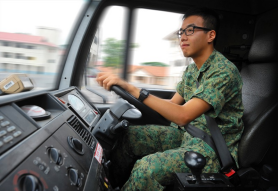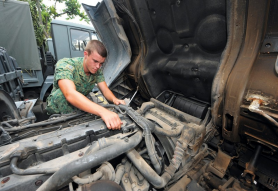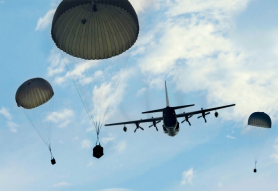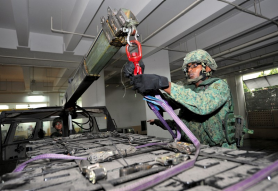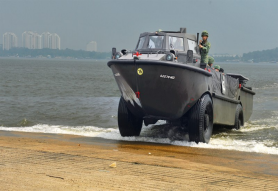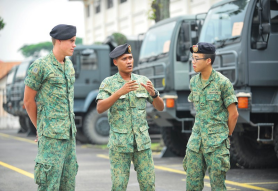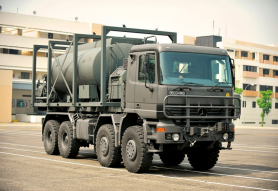TECHNOLOGY
MOVING THE SAF
01 Oct 2012
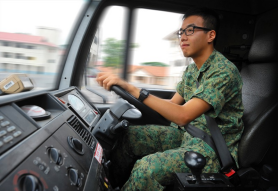
Keeping the Singapore Armed Forces (SAF) going is much more than just getting from point A to point B.
A soldier in the field might not think much about when his next meal is coming, whether he has enough ammunition to keep fighting, or even if he has a fresh set of combat fatigues to wear the next day, simply because the SAF Transport Formation is always working behind the scenes to bring these items to where they are needed.
It is not the most glamorous job but military transport personnel form the life-lines which forces at the front depend on for their survival. Each item used in the field - from the water which soldiers drink to the boots on their feet - would have been touched by SAF Transport (SAF TPT) personnel at some time.
In 2008, the SAF Integrated Motor Transport Line (IMTL) was born when the SAF Transport Hub (Central), the fourth Transport Hub, was formed.
All four hubs had Transport Nodes assigned to them, based on their locations. For example, the Bedok Transport Node, which mainly supports units in the east, fell under the SAF TPT Hub (East).
The IMTL system did away with individual Motor Transport Lines, which supported only their respective home units, so that the entire gamut of the SAF's transport capabilities would be usable by all, reducing costs and increasing efficiency.
"If I don't have enough resources to service a unit's requirements, I can call on the hub to supply the transport assets needed," said 3rd Warrant Officer (3WO) Boharei, Acting Fleet Sergeant Major of the Bedok Node, who has 14 years of experience as a transport vocationalist.
"There is also better bonding because we work with more people in the formation on a daily basis. In the past, each MTL just took care of its own requirements."
Better training
Full-time National Servicemen (NSFs) form the bulk of Transport Operators (TOs). Though young, they are entrusted with heavy responsibilities, not least of which include driving massive vehicles such as the 7.6m-long 5-ton trucks on Singapore's public roads.
The SAF's driving course takes 10 weeks to complete. In that time, trainees are expected to master road signs and laws, learn to operate the vehicles safely as well as familiarise themselves with the vehicles they are driving. Compared to the civilian equivalent, the route to obtaining an SAF driving licence is a much more demanding process.
During the course, trainees first practice on the Driver Training Simulation System (DTSS), before going on the roads. Whether it is zipping down a highway or fording knee-deep waters, the DTSS is able to simulate it all at the flick of a switch.
Then, there is a situational test which sees the trainees role-play various scenarios with their instructors on realistic game boards while "piloting" car models. During the test, trainees have to react to the scenarios given by their instructors and describe what they are doing at every step.
The last few weeks of the course see the TO trainees negotiating the 36ha Cross-Country Driving Circuit near the Mandai training area.
"The SAF driving course really drills the trainees so that they are ready to operate their vehicles under most conditions and know what to do during contingencies such as break-downs," said Military Expert (ME) 5 Jason Sim, Head Systems Development Section, Headquarters SAF TPT.
The training does not end there; once they have their SAF licences in hand, the trainees are packed off for a full day of round-island driving designed to orientate them to the roads most commonly used by the SAF, such as major expressways and routes between SAF camps.
Safety emphasis
They might not have noticed it, but almost everyone PIONEER spoke to for this story repeated the word "safety" many times.
With a large fleet comprising vehicles that easily match container trucks in size, it is no wonder that safety is highly prized in the Formation.
When out in an SAF vehicle, seat belts are a must and instructions to fasten the seat belts while the vehicle is in motion are always included in the brief which a TO delivers before each detail. Reverse buzzers, which sound when the vehicle is reversing, are also progressively being fitted on the SAF's transport assets.
The Formation is looking into ways to monitor driver fatigue, in collaboration with the DSO National Laboratories, and is studying the feasibility of installing collision-avoidance camera systems similar to those found in high-end passenger cars to enhance safety for its TOs and other road users.
"We are also looking into a smartphone application which our TOs can use to gauge their level of alertness before going out on the road," said ME5 Sim. The app, which has users answering simple logic-based questions, measures response times and the number of correct answers to ascertain if users are fatigued.
Going places
While on the road, TOs are ultimately responsible for the health of their vehicles and the well-being of their loads and passengers. Corporal (CPL) Ahmad Bashir Bin Omar recounted his first detail which involved ferrying a Lieutenant Colonel (LTC) within an exercise area.
"Being fresh out of the SAF driving school, I was terrified when I saw such a senior officer on my first detail!" said CPL Bashir from the Clementi Node, SAF TPT Hub (Central).
Another trip, this time on Jurong Island, saw CPL Bashir taking Chief of Army (COA) Major-General Ravinder Singh as a passenger during a visit to the troops performing their duties over the New Year holiday period.
"As usual, I turned around, before moving the vehicle, for a short safety brief and reminded my passengers to fasten their seat belts," said CPL Bashir, who was involved in the 24/7 SAF-led security operations on Jurong Island from April to December last year.
"Looking back, how many NSFs have had the opportunity to speak with COA during their service? Being a TO has taken me to places and given me chances to meet people whom I would likely never encounter."
Qualified to operate seven different types of vehicles, CPL Bashir added: "Some people think that TOs have it easy but that is not true; there is a lot of responsibility when you are driving huge vehicles."
Managing the fleet
Armed with the capability to move just about anything the SAF has in its inventory, the Transport Formation operates a mind-boggling array of transport assets which includes 19 major models of land vehicles.
This number increases exponentially when variants are taken into account; the High Mobility Cargo Transporter (HMCT) can be fitted out with a massive fuel tank complete with refuelling nozzles (used to supply fuel to the SAF's combat vehicles in the field) and the Multi-Role Utility Vehicle can be retrofitted to become a fully-capable ambulance.
Ensuring that these vehicles are constantly ready and serviceable takes planning to a whole new level. Taking care of these maintenance requirements at the Bedok Node is 3rd Sergeant (3SG) Philip McCormick, who manages a fleet of about 250 vehicles. Each month, about 15 vehicles from the Bedok Node are scheduled for regular servicing and inspection tests.
"We use a computer system which keeps track of the state of each vehicle and we know the state of all the vehicles operated by the node at any time, so that simplifies things," explained 3SG McCormick. The 20-year-old NSF is a Transport Supervisor.
This state-of-health information is then relayed to Headquarters SAF TPT located at Kranji Camp III which oversees the Formation's operations and future planning work.
This is done through the Integrated Transport Management System, (ITMS) allows units to indent vehicles and request for TO support. It optimises and allocates the resources for each request and tracks the movement of vehicles in real-time when necessary. It also constantly monitors the availability of all its assets and the status of each operator.
Move out!
During peacetime, the Formation supports all manner of SAF operations mainly by performing supply runs and transportation for troops on training. It also supports large-scale national events such as the Asia-Pacific Economic Cooperation meeting and the Singapore 2010 Youth Olympic Games.
Though a significant portion of the SAF's transport assets are out and about at any given time, its operational standard operating procedures are never neglected.
For example, SAF TOs are trained to operate their vehicles at night. One visual reminder of that can be found on all SAF transport assets: the black-out panels and switches on the dashboards. At the flick of a switch, headlights can be dimmed to a barely perceptible slit and rear brake indicators are replaced by a small dot of red light.
In the operators' cockpits, black flip-down panels cut the light of the dials and other indicators to a bare minimum so as to keep the vehicles' visual signature as low as possible.
In addition, the SAF TPT Battalions (BNs) conduct a series of readiness exercises ranging from civilian-resource acquisitions to large-scale training deployments of its transport assets each year. In times of war, civilian cargo vehicles are called in to augment the SAF's transport assets.
"This approach saves cost for the SAF because we don't have to maintain a larger fleet than is necessary (during peacetime), and yet we can meet our operational requirement," said ME5 Sim.
Up in the air
In areas where the SAF's land transport assets are unable to safely traverse due to rough terrain or the presence of opposing forces on the ground, the Air Terminal Company (ATC) is called in to provide aerial resupply.
One of the companies under the 3rd SAF TPT BN, ATC provides the SAF with the expertise to conduct air-drop and under-slung operations. "For air-drop operations, we can rig even the most fragile loads to be delivered via specialized parachutes," said Captain (CPT) Twelve Lim, Officer Commanding, ATC.
Every member of ATC is trained in the specialised skill of rigging loads for air-drop operations. "We train to rig continuously for up to 48 hours at a stretch and that in itself is quite tiring because some of the loads we handle are really heavy," said CPT Lim.
In a testament to their skill in aerial resupply, the ATC successfully air-dropped fresh eggs, together with other supplies, for exercise troops during a training exercise held in Australia last year. "All the eggs arrived intact and I was told that the ground troops were very happy to have them!" said LTC Melvin Tan, former Commanding Officer, 3rd SAF TPT BN.
Over water
When the SAF needs to move supplies across water obstacles, it calls upon the capabilities of the Lighter Amphibious Resupply Cargo V (LARC V) - which can move on both land and water.
A cross between a boat and a transport truck, the LARC V stands out not just because of its unique exterior, but also because its operators have the distinction of being among the few in the Army to hold the job title of "coxswain". The title is normally reserved for Republic of Singapore Navy (RSN) personnel.
To be qualified to operate the LARC V, the coxswains attend a two-week course conducted by the RSN, and also attend the same driving course which TOs go through.
As always, safety is paramount when operating the LARC V - a craft that measures more than 10m in length. "On land and water, we always have other crew members helping us to keep a lookout to ensure that we stay safe," said Lance Corporal (LCP) Ananth s/o Asogan.
With the capabilities to move the SAF over air, land and sea, soldiers can take comfort in the knowledge that they will be well supplied wherever they may be.
"Some people think that Transport Operators have it easy but that is not true; there is a lot of responsibility when you are driving huge vehicles."
- CPL Bashir
Supplying the front
How the SAF Transport Formation moves supplies to sustain operations.
Front-line troops depend on regular supply runs to top up warfighting supplies. Using its air, land and sea capabilities, the SAF Transport Formation ensures that troops are well fed and armed for their next mission.
1) Troops in tough terrain impassable to land vehicles are re-supplied through air drops via the C-130 transport aircraft.
2) The Division Support Area functions as the nerve centre. Apart from planning and coordinating supply operations, it also monitors supply levels and dispatches transport assets to other nodes in the supply network to meet front-line demand.
3) Civil resource vehicles, such as heavy trucks and cargo vehicles, are used to augment the SAF's fleet of transport assets to carry supplies to the Division Support Area and Brigade Support Areas.
4) Main stockpile areas hold the supplies which fighting troops need for their operations.
5) Closer to the front line, the Brigade Support Area provides command and control for re-supply operations to the three forward battalions. From here on, cargo is ferried using SAF Transport vehicles such as the High Mobility Cargo Transporter and 5-ton truck.
6) The LARC V, which moves on both land and water, is used to carry supplies over water obstacles to a battalion.
Where did the 2nd SAF Transport Battalion go?
While the Transport Hub (North) houses the 1st Singapore Armed Forces Transport Battalion (SAF TPT BN) and the Transport Hub (Central) the 3rd SAF TPT BN, neither of the remaining Hubs is known by any other name. So where did the 2nd SAF TPT BN go?
The unit did exist at one time at Gillman Barracks (now home to art galleries) and its main responsibility was the conveyance of re-supplies to front-line units. Set up in 1978, the now-defunct 2nd SAF TPT BN had three Flat Bed Task Companies and two Low Loader Task Companies, named after the transport assets under its control.
As part of the restructuring of SAF TPT, it was declared defunct in 1984 and all of its companies were transferred to other TPT BNs.
SAF transport by the numbers
16.08 million km
Total average annual distance covered on land by the SAF Transport Formation.
10 weeks
The amount of time it takes to train a Transport Operator.
167,204
Average number of trips made by Transport Operators each year.
19
Number of major land-vehicle models currently in use.
ALSO READ IN TECHNOLOGY

AI joins the fight in national cyber defence exercise
12 Nov 2025
AI and closer collaboration among agencies and industry are taking centre stage in this year’s Critical Infrastructure Defence Exercise (CIDeX).
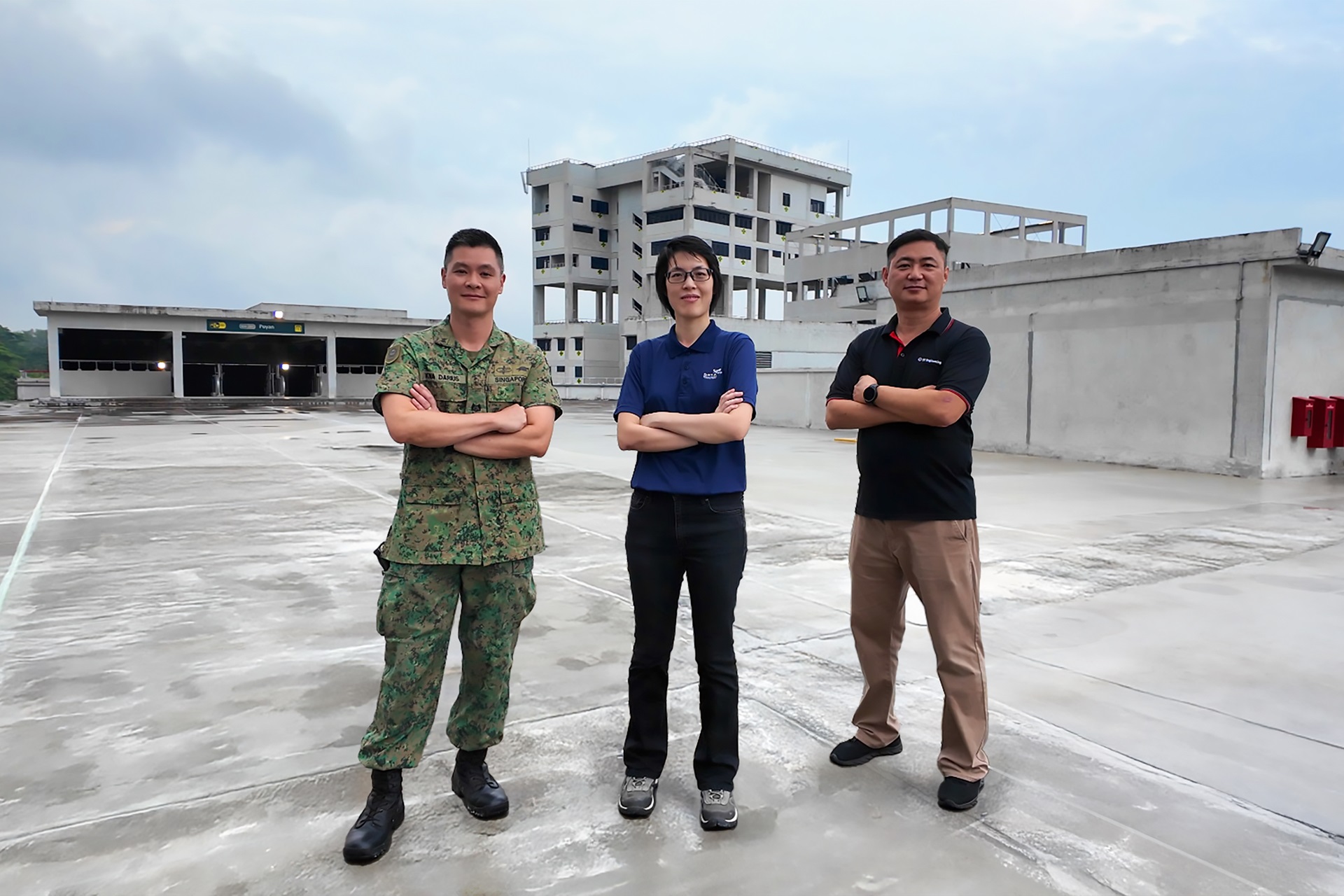
They built this city
01 Oct 2025
Turning vision to reality: the team behind SAFTI City clinches the Defence Technology Prize 2025 Team (Engineering) Award!
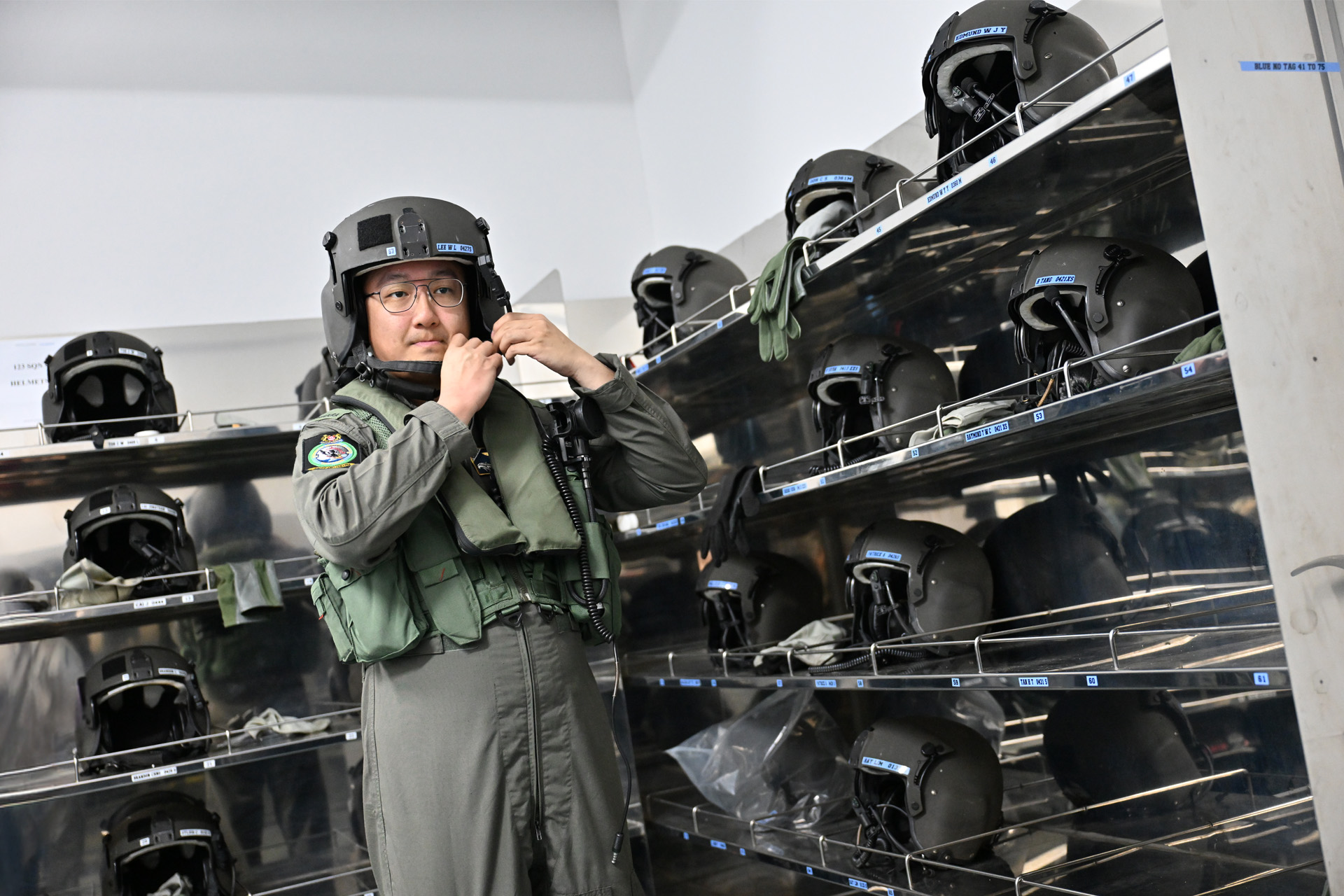
Operating over skies & seas
22 Aug 2025
This gear is designed to help a Sensor Supervisor survive emergencies in the air and at sea.

